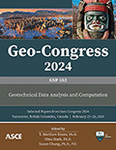Sediment Characterization Based on Portable Free Fall Penetrometer Measurements Using a Deep Neural Network
Publication: Geo-Congress 2024
ABSTRACT
Characterizing seabed sediment is vital for offshore and nearshore engineering projects, often relying on in situ tests due to challenges in obtaining seabed samples. While cone penetration testing (CPT) is the conventional choice for seabed characterization, portable free fall penetrometers (PFFP) offer a cost-effective alternative in challenging environments, focusing on surficial seabed data. However, streamlined soil classification methods for PFFP data are lacking, as CPT-based approaches may not directly apply due to different penetration rates. This study introduces a 1D convolutional neural network (CNN) to predict sediment classes using the deceleration curve from a PFFP. Soil samples from deployment sites (Sequim Bay, WA; York and Potomac Rivers, VA) underwent laboratory testing for true classification labels. Initial results exhibit an 80% accuracy, suggesting potential practical applicability with further refinement and additional training data. This approach holds promise for reliable and practical seabed sediment classification in geotechnical applications.
Get full access to this article
View all available purchase options and get full access to this chapter.
REFERENCES
Albatal, A., and Stark, N. (2017). “Rapid sediment mapping and in situ geotechnical characterization in challenging aquatic areas.” Limnology and Oceanography: Methods, 15(8), 690–705.
Albatal, A., Stark, N., and Castellanos, B. (2020). “Estimating in situ relative density and friction angle of nearshore sand from portable free-fall penetrometer tests.” Canadian Geotechnical Journal, 57(1), 17–31.
Bridle, J. (1989). “Training stochastic model recognition algorithms as networks can lead to maximum mutual information estimation of parameters.” Advances in neural information processing systems, 2.
Cetin, K. O., and Ozan, C. (2009). “CPT-based probabilistic soil characterization and classification.” Journal of Geotechnical and Geoenvironmental Engineering, 135(1), 84–107.
Domingos, P., and Pazzani, M. (1997). “On the optimality of the simple Bayesian classifier under zero-one loss.” Machine learning, 29(2), 103–130.
Goodfellow, I., Bengio, Y., and Courville, A. (2016). Deep learning. MIT press.
He, H., Bai, Y., Garcia, E. A., and Li, S. (2008). “ADASYN: Adaptive synthetic sampling approach for imbalanced learning.” In 2008 IEEE international joint conference on neural networks (IEEE world congress on computational intelligence),1322–1328.
Jaber, R., and Stark, N. (2022). Towards correlating seabed penetrometer and chirp sonar measurements. In Cone Penetration Testing 2022 (pp. 159–164). CRC Press.
Jung, B. C., Gardoni, P., and Biscontin, A. (2008). “Probabilistic soil identification based on cone penetration tests.” Géotechnique, 58(7), 591–603.
Kiranyaz, S., Avci, O., Abdeljaber, O., Ince, T., Gabbouj, M., and Inman, D. J. (2021). “1D convolutional neural networks and applications: A survey.” Mechanical systems and signal processing, 151, 107398.
Nair, V., and Hinton, G. E. (2010). “Rectified linear units improve restricted boltzmann machines.” In Proceedings of the 27th international conference on machine learning (pp. 807–814).
Olsen, R. S., and Mitchel, J. K. (1995). “CPT stress normalization and prediction of soil classification.” In Proceedings of the International Symposium on Cone Penetration Testing, CPT'95 (Vol. 2, pp. 257–262).
Robertson, P. K. (1990). “Soil classification using the CPT.” Canadian Geotechnical Journal, 27(1), 151–158.
Smith, L., Stark, N., and Jaber, R. (2023). Relating side scan sonar backscatter data to geotechnical properties for the investigation of surficial seabed sediments. Geo-Marine Letters, 43(2), 9.
Stark, N., Green, B., Brilli, N., Eidam, E., Franke, K. W., and Markert, K. (2022). Geotechnical Measurements for the Investigation and Assessment of Arctic Coastal Erosion—A Review and Outlook. Journal of Marine Science and Engineering, 10(7), 914.
Stark, N., Parasie, N., and Peuchen, J. (2022). Deepwater soil investigation using a free fall penetrometer. Canadian Geotechnical Journal, 59(12), 2196–2201.
Information & Authors
Information
Published In
History
Published online: Feb 22, 2024
ASCE Technical Topics:
- Artificial intelligence and machine learning
- Bodies of water (by type)
- Computer programming
- Computing in civil engineering
- Engineering fundamentals
- Equipment and machinery
- Field tests
- Geomechanics
- Geotechnical engineering
- Geotechnical investigation
- Laboratory tests
- Measuring instruments
- Neural networks
- Penetration tests
- River engineering
- Sea floor
- Seas and oceans
- Sediment
- Soil classification
- Soil mechanics
- Tests (by type)
- Water and water resources
- Water management
Authors
Metrics & Citations
Metrics
Citations
Download citation
If you have the appropriate software installed, you can download article citation data to the citation manager of your choice. Simply select your manager software from the list below and click Download.
